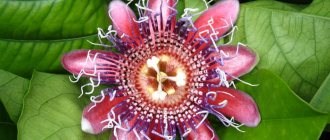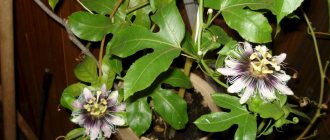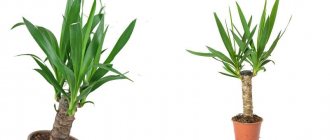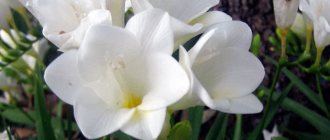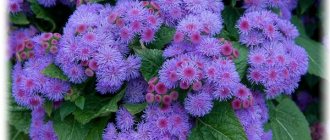History of the discovery of a flower
The homeland of most passionflower species is the tropical and little-explored forests of South America; some types of flowers are also found in Asia and Madagascar. Europe became acquainted with this plant only after the conquest of the New World.
The passionflower flower has a complex and original structure - at the top of the petals there is a “crown” consisting of long scales, behind which there are large stamens. Even higher there is a pistil and 3 stigmas (see photo of edible passionflower). Because of this appearance, missionaries who came to America and the Catholic Church considered the flower to be Christ's crown of thorns and banned its study. The first description of passionflower was made only in the twentieth century.
Why passionflower leaves turn yellow: main pests and diseases
Under natural conditions, the main pests of most passionflower species are Heliconia caterpillars. But in temperate continental climatic conditions, the plant suffers from other pests and diseases: mealybugs, spider mites and thrips cause the death of passionflower.
Proper care is not always a guarantee that an uninvited guest will not appear on the plant.
Mealybugs can settle on young shoots, in leaf axils or in buds. The pest feeds on passionflower juice and causes mold to appear. Its reproduction is facilitated by a large amount of nitrogen-based fertilizers and a favorable ambient temperature of about +26˚С.
Products containing cypermethrin, including Arrivo and Intavir, will help destroy mealybugs.
Spider mites also need passionflower cell sap to function . The leaves of a houseplant with this pest begin to turn yellow for no apparent reason, and then dry out. The presence of a mite can be identified by yellow dots on the leaves: despite its name, the pest secretes very little secretion, which forms filaments. The web can only be seen when a large number of spider mites accumulate.
Thrips are small insects of light yellow, brown or black color. It is not difficult to distinguish them from other insects: these pests move quickly, making jumps to small heights. In a short time, thrips can destroy a home flower: on passionflower they quickly multiply, feeding on the juice from the leaves and flower nectar. Damaged areas of the plant become discolored and acquire a light silver tint. Small brown or brown spots can be seen on the inside of the leaf.
Sometimes the answer to the question of why the leaves of domestic passionflower turn yellow in the spring-summer season is the appearance of pests that undermine the root system or leaves.
Spider mites and thrips can be easily destroyed with special products that can be found in every flower shop. "Aktara", "Aktellik" or "Fitoverm" will do. Following the instructions on the package, the plant is processed several times. It is necessary to destroy not only pests, but also their larvae.
In addition to insects, infectious diseases can spoil the plant. Domestic passionflower is occasionally affected by late blight, scab, various types of spotting and yellow mosaic virus. It is not possible to get rid of them without harming the passionflower: the affected parts of the plant are removed, and the cut is treated with a solution of potassium permanganate. They also use products to combat infectious plant diseases. For late blight, a 2-3% solution of copper sulfate or Fitosporin-M will help the plant; fungicides are used for scab. If there is no effect, the passionflower will have to be destroyed.
It is worth considering that when pests appear, you need to limit the contact of the passion flower with other plants (it is advisable to move it to another room).
Biological description
This perennial plant can grow up to 3-4 m in length; it produces very long shoots that cling to supports with tendrils. The leaves are large, consisting of 3-5 lobes. The fruit of passionflower is a juicy multi-seeded berry; there are up to 60 edible species of passionflower, many of them are even grown as fruit plants.
The most famous and popular edible varieties of passionflower:
- Passion fruit.
- Granadilla.
- Maestro.
- Galaxy et al.
Pruning when caring for passionflower: how to trim a flower while growing
After the first year of active growth, passionflowers begin to be pruned. This procedure is carried out every spring: it stimulates the development of plant shoots and their beautiful branching.
Pruning home passionflower involves removing dry or rotten branches and pinching shoots. Flower buds form only on young shoots, so last year's shoots should be cut back by a third. The branches that grow at the base of the stem are also removed. The cut areas should be treated with a solution of potassium permanganate, which will prevent rotting or the development of infection.
If you follow the advice and prune passionflower in the same way as experienced gardeners recommend, it will delight you with a thick crown and abundant flowering. The main thing is not to overdo it with removing strong and healthy shoots, because after this the plant may get sick.
Maintenance and care of the plant
Edible passionflower (or passion fruit) is a fast-growing vine that can be planted both in open ground and at home. The main condition for successful growth is sufficient lighting, so it cannot be grown in the shade or under a dense tree crown.
Optimal temperature for growth: +18...+24 ˚С, at higher temperatures the leaves begin to turn yellow and dry out, the number of buds decreases, and the death of the plant is possible. In winter, during the dormant period, it is kept at +12…+18 ˚С.
The soil for passionflower is light, well permeable to air, for which sand or peat is added to it.
The flower requires frequent watering during the period of growth and flowering (from spring to late autumn), the soil should always be slightly moist, in the summer it is watered every other day. During the dormant period in winter, watering is done once a week or even less often. Passionflower is demanding on air humidity; in the summer it should be sprayed frequently, but the sun's rays must not burn the leaves through the drops.
Plants are fertilized twice a month using complex mineral mixtures. You can use liquid flower fertilizer, but diluted in half.
Passionflower does not tolerate drafts, but loves frequent ventilation. When planting, you should take into account the presence of supports along which the vine will grow upward. The plant must be pruned frequently, especially shoots after flowering, which are cut off completely. In spring, pruning is done to 1/3 of the length, since flowers will only be placed on fresh shoots.
Passionflower or passion fruit
08.28.2018 Plants of the genus Passiflora
(lat.
Passíflōra
) are tropical evergreen vines, well known for their decorative value, some of which can reach a length of up to 45 m. Passion flowers are native to a region of tropical forests with a humid and hot climate, located in South America. It covers the southern regions of Brazil, the territory of Paraguay and the northern part of Argentina. The high decorative qualities of passiflora (openwork leaves, original structure and coloring of flowers), its rapid growth, long flowering period and unpretentiousness contributed to the wide spread of the crop in horticulture, as well as its use in vertical gardening, for decorating gazebos, pergolas, creating shady areas, etc. . P.
Among the numerous representatives of passionflower, there are plants with both whole and palmate (three-, five-, nine-lobed) leaves. Passionflower flowers are single, large (on average about 10 cm in diameter), with a bright and elegant double perianth, above which straight or wavy fiber-threads of multi-colored colors are placed in the form of a fringe, forming a kind of “crown”. In the center of the flower there are five stamens, above them rise three cross-shaped stigmas. Servants of the Christian religion used the unique structure of passionflower flowers to symbolize them as the personification of the suffering (passion) of the Lord, which gave rise to the name of the plant. Translated into Russian, passionflower means passion flower.
Of the more than 500 species of passionflower, only a few (including passion fruit
,
Passiflora mesokrasa
,
Chulyupa
,
Passionflower reed
, etc.) form edible berries, which are a valuable food and dietary product. In addition, the fruits of passionflower, as well as its aerial part, have medicinal properties and are successfully used not only in folk, but also in official medicine. Flavonoids, carotenoids, alkaloids, coumarins, glycosides, saponins, quinones, vitamins and microelements, as well as many other useful components were found in the stems and leaves of the plant.
Shoots, buds and flowers are harvested during the flowering period of passionflower, then dried in a shaded, well-ventilated room or at a temperature of +50...60°C. Tea, infusions and extracts from dried herbs are used as antispasmodic, antibacterial, and antifungal agents. Passionflower is included in pharmaceutical preparations that have a sedative effect. It is also used as a biologically active component that helps get rid of alcohol and drug addiction.
Today, passionflower fruit species are cultivated as perennial climbing fruit-bearing plants not only in Brazil, but also in the Mediterranean countries, subtropical zones of Asia, New Zealand, Australia, and the islands of Polynesia. One of the most common and famous among them is edible passionflower.
(lat.
Passiflora edulis
, Passionflower family), also known as
passion fruit
,
granadilla
or
edible passionflower
. It is an evergreen herbaceous vine up to 10 m long, forming unusually beautiful, bright flowers. After pollination (with the participation of hummingbirds in their natural habitat or artificially when grown in other regions), fairly large (8 - 15 cm) fruits are formed.
The fruit of edible passionflower, well known to us as passion fruit, has a spherical shape, covered on top with a dense glossy skin of yellow, orange or purple color, under which there is a juicy, aromatic, sweet and sour pulp filled with dense and also edible seeds (up to 30 pieces and more). It contains fiber, protein, carbohydrates, saturated and unsaturated fatty acids, pectin compounds, chlorophyll, many vitamins (A, groups B, C, PP, E, K, etc.), antioxidants, macro- and microelements (potassium, calcium, sodium, magnesium, iron, copper, zinc, phosphorus, sulfur, fluorine, etc.). The calorie content of 100 g of fruit is 68 kcal. The fruits are eaten fresh, selecting the pulp from the berries cut in half. Passion fruit is often used as a flavoring and filler in fermented milk and tonic drinks, in desserts, and ice cream. Jams, jellies, juice, syrup are made from it, and added to hot sauces and marinades.
Regular moderate consumption of passion fruit has a beneficial effect on health. This product improves the functioning of the digestive tract, helps restore the functions of the genitourinary system, regulates hormonal levels (especially during menopause and menopause), strengthens blood vessels, improves immunity, relieves depression and other disorders of the central nervous system, and headaches (leaves and seeds ), is an effective means for the prevention of cancer. Passion fruit also has a rejuvenating effect, improving the condition of hair and skin. This property of the fruit is used in cosmetology: passion fruit oil is included in many anti-aging creams, masks, restorative shampoos, gels, etc.
At the same time, it is necessary to remember about contraindications. Passion fruit is not recommended for use by people susceptible to allergic reactions, with urolithiasis or cholelithiasis, stomach or duodenal ulcers, as well as in the case of cardiovascular diseases (myocardial infarction, angina pectoris, atherosclerosis, hypotension). Caution is required when including this fruit in the diet of pregnant women, nursing mothers and children under 3 years of age. In addition, passion fruit (mainly the seeds of the fruit) can cause drowsiness and decreased attention, which is dangerous for those whose profession requires quick reaction and increased observation.
Although passionflower is a heat-loving plant, in regions with more severe climatic conditions it is grown as an annual. It can also successfully grow and develop in closed ground (greenhouses, conservatories, winter gardens, etc.) or in the form of an indoor potted plant, like an ampelous plant. Passionflower propagates using seeds (a more labor-intensive method), which are placed in a container with soil at the end of February - beginning of March or vegetatively (by cuttings).
To grow passionflower at home, you need to select a small but fairly tall container (flower pot) for the plant, fill it with a drainage layer (expanded clay, crushed stone, brick chips) at least 2.5 cm high and a loose, breathable soil mixture (leaf humus , compost, sand, turf soil) with a neutral or slightly alkaline pH reaction. The seeds are preliminarily scarified with a small amount of sandpaper, treated with a growth stimulant and planted in a container (flower pot) with a damp soil mixture, which is then covered with film. The optimal temperature for emergence is +20…25°C with a humidity of 75%. Shoots may appear within 30 days or more, after which the film is removed.
Passionflower is a light-loving plant, but can also grow in partial shade. Like all vines, it needs support. If you grow passionflower in hanging pots as a hanging crop, then it is necessary to prune the plant in time. Cut shoots (at least 20 cm long, with two internodes) also represent planting material: they can be easily rooted by first placing them in a jar with water and a small piece of charcoal, and when roots appear, in prepared soil. When placing a container with a plant indoors or outdoors, remember that passionflower does not tolerate drafts.
Passionflower needs constant moistening of the air and soil (without allowing the soil to become waterlogged or water to stagnate), especially in the summer. Spraying is carried out in such a way that the plant is not in direct sunlight at this time. In winter, during the dormant period (December - January), watering is almost stopped, making sure that the soil does not dry out, and the ambient temperature at this time should be within +12...18°C. A sufficient amount of moisture has a beneficial effect on the development of the crop. Excess nutrients in the soil provokes the abundant formation of vegetative mass of the plant to the detriment of the quantity and quality of fruits, so mineral fertilizers should be applied sparingly.
It must be borne in mind that the plant is extremely sensitive to temperature conditions.
Passionflower does not like cold, nor does it like excessive heat: at air temperatures below +12°C and above +30°C, it stops its growth. Flowers are formed on the shoots of the current year. Interestingly, under natural conditions, passionflower copes with pests (heliconia butterfly caterpillars) on its own. On its above-ground organs (leaves, petioles) there are glands that secrete a specific substance that attracts ants, which destroy dangerous caterpillars. Share on social networks:
Propagation of passionflower by cuttings
Edible passionflower can be propagated in several ways, the easiest of which is by cuttings. The apical cuttings that have buds are cut to a length of up to 10 cm in the summer, and then rooted in the soil in a warm room (+20...+25 ˚С). To prepare the soil mixture when planting, take 3 parts of leaf soil, 2 - humus, 2 - turf, 1 - sand.
Immediately before planting, they are treated with root, then the pot with cuttings is covered with film, and within 1 month the cuttings take root. You can put the cuttings in water, adding a piece of charcoal, for 1.5-2 months. roots should appear, but the water should not be changed.
During the growing season, you can also propagate by mustache.
How else can you propagate passionflower: options for propagation by cuttings
A well-known way to propagate indoor passionflower is by cuttings, which requires healthy spring shoots of an adult plant. Each of them should have 4-5 leaves and a growing point. The pair of leaves that are located below must be removed, and the cut of the shoot should be treated with a root former.
Further options are possible: the cuttings are rooted in a substrate or container with water.
If there is suitable soil (chernozem and turf soil) for propagating passionflower using prepared cuttings, choose a special container. A clay pot with small holes at the bottom is ideal. A drainage layer is placed at its bottom, which is covered with substrate. Using a pencil or any stick of the same thickness, make holes in the ground that reach the drainage. Cuttings are placed in them, making sure that the leaves are flush with the ground.
This method of cutting homemade passionflower requires little effort: the substrate is constantly moistened, and the plants create a mini-greenhouse above the future seedlings. You need a support, which is used to construct a small arch. It should be slightly higher than the top leaves of the cutting. The structure is tightly covered with a transparent plastic bag, which is removed daily for 5-7 minutes.
Ventilation is necessary for cuttings, but the temperature inside the greenhouse should not fall below +22˚С. All this time, the soil is moistened, preventing stagnation of liquid. After 20 days, the polyethylene can be removed, and when the seedlings are stronger, transplant them into a flower soil mixture for passionflower.
The main thing is to remember that such propagation of exotic passionflower occurs only in the spring by lignified apical cuttings at a soil temperature of +22 °C.
The cuttings will also begin to develop a root system if you place them in a jar with water and a piece of charcoal. The liquid is not changed for a month and a half until the first roots appear.
The air temperature requirements are similar: it can vary from +20 to +22˚С. When the first roots appear on the cuttings, they can be planted in a substrate suitable for passionflower. This is a simple way to grow passionflower seedlings at home. When the cuttings are in water, it is easy to control the process of root growth. But when planting future seedlings in the ground, you need to be careful, because they are very fragile.
For the first 2-3 weeks, seedlings should be protected from the slightest change in temperature and ensure that the soil is constantly moist.
Propagation of passionflower by seeds
Propagation by seeds is a longer process than by cuttings. In addition, very often the seeds do not germinate well due to long storage (sometimes several months). With this method, certain rules must be followed:
- growing edible passionflower from seeds begins in February;
- The soil mixture must be disinfected before planting: roast in the oven for 10 minutes. at 200 ˚С;
- the seeds are sown in the soil to a depth of 1 cm. Then the container is covered with film or glass, the room temperature should be +22...+24 ˚С. When the first leaves appear, pick them into separate pots with a diameter of more than 7 cm;
- Edible passionflower seeds have a hard shell, so to soften it they do scarification - lightly rub them with sandpaper on both sides;
- then soak the seeds for a day in milk or in a solution of citrus juice (lemon or orange);
- only then planted in a container or peat cups;
- Every day the container needs to be ventilated, for which the film is removed for 5 minutes;
- the soil is moistened as it dries by spraying;
- As soon as the sprouts appear, the film is removed and the container must be moved to a place with good lighting.
Growing passionflower
The passionflower plant is a heat-loving plant that requires frequent moistening of both the roots and the foliage crown. It grows well and bears fruit in open, sunny places, at temperatures from 20 degrees Celsius. Passionflower, its main varieties, grow all year round as indoor plants. Only a few varieties out of 400 bred and successfully grown can be left to spend the winter outside, still having to build a shelter. The majority of varieties require digging up the entire bush and moving it indoors for the autumn-winter, cold period.
Planting and flowering passionflower
This plant is a perennial; it is replanted once a year in the spring. When planting a small plant in the first year, it should be covered with a glass jar for 2 weeks. In the first year, passionflower forms the basis of the future vine, growing the main shoots, usually up to 1.5 m long. At the same time, it definitely needs support to gain a foothold.
In autumn, when the temperature begins to drop below +15 ˚С, the plant must be moved to a room where the temperature can be maintained at +13…+16 ˚С. If the room is hot, the vine begins to go bald and loses its leaves.
In the spring of the second year, you should prune last year's long shoots by a third of the length, taking into account that the flowers will form on fresh shoots. Passionflower blooms almost the entire summer season from June to October, but each flower lives only 1 day.
It is difficult to grow fruits indoors. To get them, you must have at least 2 plants of the same species, since they are cross-pollinated. Due to mismatched flowering on these plants, pollination may not occur. Fruits of various plant species usually ripen within 2-3.5 months.
Let's look at different varieties of edible passionflowers.
Growing at home
Even an inexperienced gardener can maintain passionflower at home. Before buying seeds or sprouts, you need to be prepared for the fact that a young passionflower will grow for several years before it blooms. By following the rules of plant care, you can get fruits at home.
Growing from seeds
If desired, you can grow passionflower from seeds. Before planting in a pot, passionflower seeds should be kept in warm water with a growth stimulator. The finished seeds should be placed in the soil to a depth of 5 mm and sprinkled with a small portion of soil, then watered. The seedlings will appear 2-2.5 weeks after planting. Young plants should be provided with good lighting and regular watering. The plant feels good at a temperature of 20-25°C in summer and at 11-14°C in winter. After transplanting the sprout to a permanent place, you need to install a support for it.
Caring for passionflower
Liana does not like stuffiness, dry air and drafts. In the warm season, you can leave the plant on the balcony. Watering should be regular to prevent the soil from drying out. During the summer months, it is advisable to spray the foliage with a spray bottle. To maintain the required level of humidity, you should add certain components to the pot tray, for example, peat, expanded clay. In winter, it is enough to lightly moisten the soil to prevent it from drying out completely. To encourage flowering and growth, annual pruning is necessary. First, it is done in the spring - a third of the old shoots are cut off, in the summer the soil is cleared of growth, after the flowers wither, the bare stems are completely cut off, and the rest are reduced by a third.
Fertilizing should be done from early spring to early autumn. It is advisable to apply it 2-3 times a month after watering. Passionflower prefers organic matter and mineral complexes.
Passionflower in a pot on the windowsill
Propagation using cuttings
Passionflower can be propagated by cuttings. This is convenient to do in the spring. For cuttings, take shoots growing in the middle, measure 5 cm from the shoot bud and cut it. The cut should be treated with a special solution designed to stimulate root growth. The cutting is placed in a container filled with drainage mixture and soil. It is necessary to make a hole for the cutting in advance. After planting, the shoot is watered and a small greenhouse is made, covering it with film. Once a week it is removed for ventilation. The plant should remain in the greenhouse for about 30 days after planting. To activate the process of root emergence, you can place the cut in water.
Types of passionflower
Passion fruit or Granadilla (Passiflora edulis) is the most common species, native to Uruguay, Brazil, and Argentina. In cultivation it grows up to 5-8 m, has matte three-lobed leaves. There are two varieties of it: with yellow fruits and purple ones. The flowers are very large (6-8 cm) light purple, and the fruits are round in shape up to 6 cm in size. Drinks and sweets are prepared from them, and added to tea.
Banana passionflower (Passiflora mollissima) grows naturally in Bolivia, Venezuela and Colombia. The flowers are pink, up to 12 cm in size, the fruits emit a pleasant aroma. Of all the species, banana passionflower is the most cold-resistant, bearing fruit in the first year.
Passiflora edible Galaxy is a perennial climbing plant, vines grow up to 4.5 m long, flowers up to 12 cm in size are white and pink. The fruits are brown-red and have a pleasant aroma.
The largest in terms of fruit size and stem length - Passiflora quadrangularis - grows up to 15 m in length, the flowers are also large, up to 15 cm in diameter, the fruits are large, oval-shaped up to 30 cm, have a thick peel, and inside there is sweet juicy pulp . In the middle zone, such a plant can only be grown in greenhouse conditions.
Edible passionflower Maestro is one of the popular and widespread varieties in Russia, which is successfully used by gardeners for growing indoors and outdoors.
Apple-shaped passionflower (Passiflora maliformis) or Chulyupa is a vine with a tree-like stem up to 10 m long. Its fruits are up to 5 cm in size and contain sweet, aromatic gray or pale orange pulp with black seeds. The pulp is used in making drinks. Plantings of this species are grown in Brazil and Ecuador for their edible fruits.
Description of the plant
Passionflower belongs to the Passionflower family. The botanical name "Passiflora" translates as flower of suffering. Maybe that's why it is often called passion flower. This is a perennial evergreen shrub in the form of a vine or annual grass. Their natural habitat is the tropics. It grows naturally in Australia, the Mediterranean, Asia and Peru. But some types of passionflower are also readily grown at home, primarily because of their spectacular appearance and unusual colors, as well as because of their medicinal properties and edible fruits.
The plant has a well-developed and strong root system. The thickness of the main root can reach several cm, and the length can reach several meters. Smooth thin stems reach ten meters or more in length. In the tropics there are specimens that, persistently making their way towards the sun, reach 45 meters in length.
The dark green simple leaves of passionflower can be whole or lobed. The leaves are arranged alternately on petioles about 3 mm long. Unusual star-shaped flowers are formed on long stalks, the diameter of which varies from 5 to 15 cm in different species. The flower has five sepals, five petals and large bracts. In the center of each bud there are three stigmas, which are surrounded by five stamens with rather large anthers.
Passionflower blooms starting in July, all summer and part of autumn. Flowers are short-lived. Each flower lives no longer than one day. In nature, there are a huge number of flowers on vines. And at home you will have to make sure that the plant has as many buds as possible.
After flowering, many species form large (from 6 cm to 15 cm in length), edible fruits, weighing up to two or more kg. Both flowers and fruits have a pleasant aroma.
Diseases and pests of passionflower
Edible passionflower can suffer from attacks by spider mites, aphids, mealybugs and whiteflies. You can protect the plant with the help of “Fitoverma” or “Aktara”; to destroy scale insects, preparations containing cypermethrin (Arrivo, Inta-vir) are used.
Infectious diseases that can threaten the plant are root rot, late blight, ring and brown spot, scab, fusarium, and very rarely, yellow mosaic virus. It is very rare to cure a diseased plant, so it is destroyed along with the pot.
Overwintering passionflower: why the plant sheds its leaves in winter
Many gardeners are thinking about the question of how to preserve heat-loving passionflower in winter. Passion flower is native to tropical forests, so it has difficulty adapting to short daylight hours. It can grow with pronounced seasonal temperatures: in summer it loves warmth, in winter - about +10 ° C. But cold winter drafts, dry air from radiators or too high (from +16˚С) artificially maintained room temperature can cause irreparable harm to the plant.
Don't worry if your passionflower sheds its leaves over the winter: they will grow back in the spring. During the cold season, the plant cannot be replanted and watered frequently (dormant roots may rot). Despite the fact that daylight hours are becoming shorter, the passionflower is not additionally illuminated. If it is not possible to create an optimal temperature regime in winter, the plant is simply left alone, choosing the most suitable place for this in an apartment or house. The main condition is the absence of sudden temperature changes and humidity control.
If passionflower leaves quickly turn yellow, this is a signal to the owner that the plant does not have enough sunlight, or the temperature in the room is too low for exotic plants. Withered leaves can also signal that excess fertilizer has been added to the soil. In winter, it is better not to use special fertilizing for passionflower: this can lead to exotic disease.
The plant does not actively absorb substances from the substrate, and they can provoke the process of rotting.
During the wintering period of domestic passionflower, as well as in the summer, it is periodically inspected for the presence of the first signs of pest activity, infection of the plant with spotting, scab, late blight and yellow mosaic.
Medicinal properties of passionflower
Some types of passion flowers also have important medicinal value. Even the ancient Incas used passionflower as a soothing tea. The main healing effect of passionflower is sedative, improving the quality and duration of sleep without any negative consequences. The plant is used to treat diseases of the nervous system, helps with insomnia, depression, epilepsy, etc.
Also, medications prepared from this plant have antispasmodic, anti-inflammatory, anticonvulsant and analgesic effects, help improve memory, increase performance and potency. Another unique effect of passionflower - compensation for the effects of amphetamine - is used with great success to cure drug addiction and alcoholism.
The most valuable species from a medical point of view is Passiflora incarnata or apricot, which grows into a very long vine up to 10 m. The flowers are bright purple, and the fruits have a lemony tint, the size of a plum, and taste sweet and sour. The medicine “passiflora extract” is made from its aerial parts, which has a calming effect and is prescribed for diseases of the nervous and cardiovascular systems. The fruits have a very interesting smell, similar to the aroma of lilac.
What does a passionflower (passionflower) houseplant look like?
Each species of the Passifloraceae has its own characteristics in nature: it can be a shrub, an annual or perennial herbaceous plant with a strong stem. The flowers reach 10 cm in diameter and are characterized by their bright color and star-shaped shape. Between the stamens and the perianth are rows of bright filaments that form the crown. Passion flower blooms from early July to October. At the same time, its individual varieties (for example, incarnata and blue passionflower) emit a delicate aroma that quickly disappears.
The leaves of passionflower are dark green, quite large, and can be whole or lobed. On them or on the petioles there are peculiar “glands” that are invisible to the human eye.
They secrete a special liquid that attracts ants to them. These insects are necessary for the passionflower to protect itself from the main pests in the wild - the caterpillars of heliconia butterflies. The shape of the glands and their location may vary: some species have outgrowths that are visually similar to butterfly eggs. This makes the plant unattractive to insect pests, deceptively demonstrating that it is already occupied by other heliconias.
Using passion fruit for food
In our country, the fruits of edible passionflower (passion fruit and other types) can only be found in additives to yoghurt, ice cream or juice. Very rarely, a piece of the fruit can be found in tropical tea blends.
The pulp of this fruit is very tasty and sweet; in its homeland it is consumed raw, mixed with sugar and water, and for making jams, jellies and sorbets. Often pieces of this fruit are added to curd desserts and cakes.
Sweet juice and jam can be used in preparing meat and fish dishes; the fruit tastes best with nuts, apples, cinnamon and pear.
However, caution should be exercised, because some varieties (for example, Azure passionflower) contain a small percentage of cyanide, while some others contain weaker toxic substances harmful to human health.
Passion flower transplant
An adult passionflower is replanted once every 3-4 years, when the pot becomes too small.
- First you need to prepare a substrate from leaf and turf soil, peat, sand, and ash.
- The container should be 2-3 cm larger than the previous one so that the roots of the plant feel comfortable.
- Make drainage holes at the bottom of the pot and put foam, expanded clay or eggshells.
- Use a disinfected knife to separate the earthen lump from the old container and carefully place it in the new one.
- Add the required amount of soil and water thoroughly.
